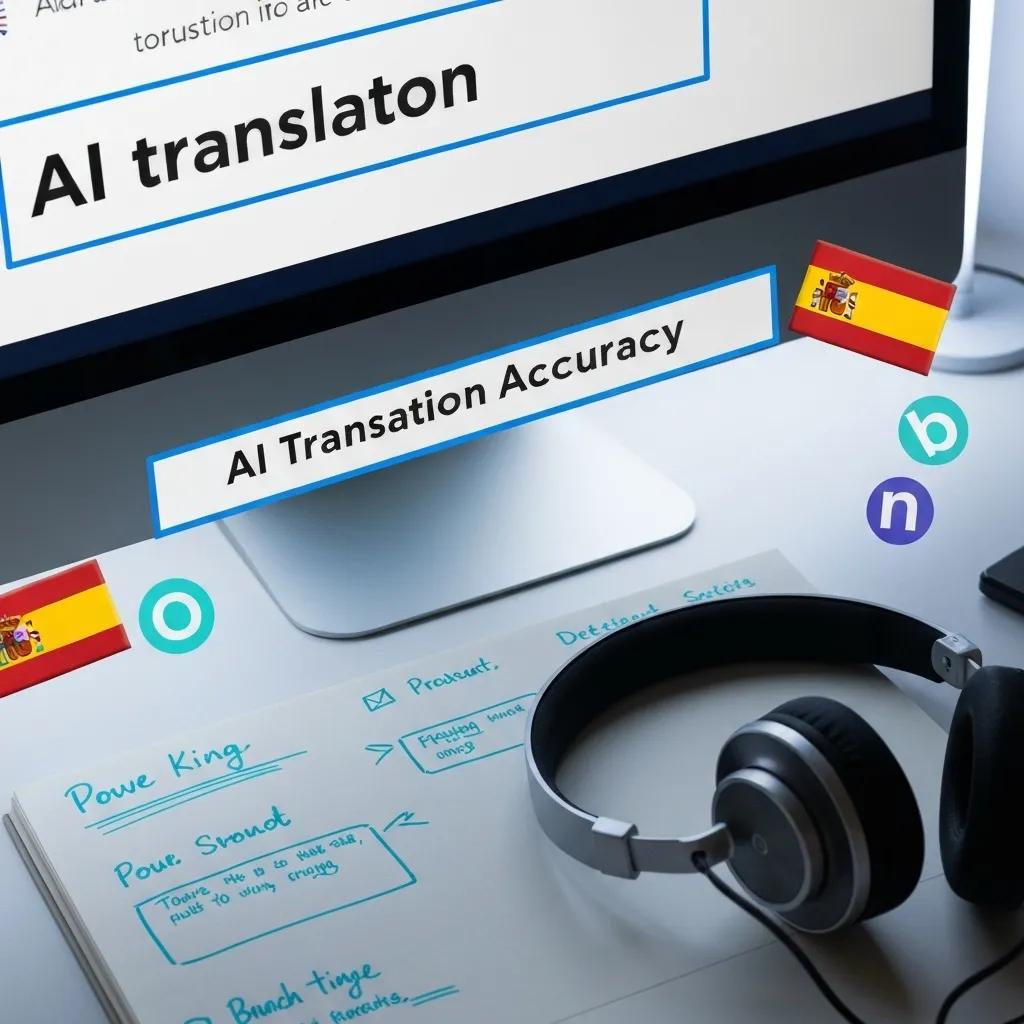AI Translation Services: Harnessing Machine Speed Without Sacrificing Human-Level Accuracy

AI translation services blend cutting-edge neural networks with human expertise to translate massive content volumes in mere seconds, all while preserving delicate cultural nuances. By employing an AI-powered Translation Management System (TMS) that includes integrated human post-editing, organizations can achieve both unmatched speed and near-human precision.
This guide delves into how AI translation drives efficiency, the elements that impact its accuracy, the hybrid workflows that elevate quality, the premier tools and platforms available, crucial ethical and security considerations, emerging market trends, and effective methods for measuring and enhancing performance.
Key themes covered:
- How AI delivers rapid throughput and cost efficiencies
- Factors influencing accuracy across various languages and subject areas
- The vital role of human post-editing in hybrid models
- Choosing and tailoring AI translation platforms
- Best practices for ethics, privacy, and security
- Future trajectory and market projections
- Metrics and tools for ongoing optimization
How Does AI Translation Deliver Unmatched Speed and Efficiency?
AI translation services automate the language conversion process using machine learning models that ingest and process entire documents in seconds, eliminating delays associated with manual copy-pasting. By entrusting initial drafts to neural networks, teams can redirect their efforts from routine translation tasks to more strategic localization initiatives. For instance, a global marketing team can deploy a complete website translation in under a minute, facilitating swift market entry and consistent brand messaging.
What Technologies Power Rapid AI Translation?
Neural Machine Translation and large language models are the driving forces behind high-speed AI translation, learning intricate linguistic patterns from vast datasets.
- Frameworks like Transformer architectures enable parallel processing of entire sentences.
- Large Language Models (LLMs) utilize self-attention mechanisms to maintain contextual coherence.
- Cloud-based GPU clusters provide the essential computational power for real-time throughput.
These foundational technologies pave the way for instantaneous text conversion and prepare systems to tackle global communication challenges.
How Does AI Translation Enable Instantaneous Global Communication?
AI translation facilitates immediate global communication by delivering localized content across websites, chat platforms, and multimedia channels without the delays inherent in human translation.
- Customer support chat can automatically translate user inquiries in real time.
- Video subtitling tools generate synchronized captions in dozens of languages.
- Social media posts adapt automatically for regional audiences.
By removing translation wait times, businesses can maintain 24/7 engagement with international customers, smoothing the path to global reach and consistent brand identity.
In What Ways Does AI Reduce Translation Costs and Scale for Businesses?
AI translation slashes costs by automating initial drafts and leveraging scalable cloud infrastructure, leading to per-word rates that are up to 60 percent lower than traditional services.
Key cost-saving benefits include:
- Volume Discounts are achieved through on-demand processing of high text volumes within a single workflow.
- Reduced Human Hours as editors focus on refining machine output rather than starting from scratch.
- Predictable Pricing based on API usage, eliminating the variability of freelance rates.
These efficiencies allow for rapid scaling: marketing campaigns, technical manuals, and legal documents can all be translated without the need for additional staffing as the business expands.
What Factors Influence AI Translation Accuracy Across Languages and Domains?

The accuracy of AI translation is influenced by the depth of its training data, its specificity to particular domains, and the inherent complexity of the languages involved. Models trained on diverse, high-quality datasets tend to produce more fluent output, while specialized terminology necessitates the use of targeted glossaries. For example, a medical report requires significantly greater precision than a social media post, highlighting the need for domain-aware AI.
Why Is Context and Cultural Nuance Critical for Accurate AI Translation?
Context and cultural nuance are essential for AI translation engines to select appropriate expressions that resonate with local audiences. Without an understanding of the situation—such as formality levels or idiomatic expressions—literal translations can misrepresent brand tone or legal intent. Preserving these subtleties ensures that the message aligns with cultural expectations and prevents potential brand missteps.
How Do Neural Machine Translation and Large Language Models Improve Accuracy?
Neural machine translation enhances accuracy by modeling entire sentence sequences, capturing dependencies between words rather than translating segment by segment. Large language models further improve contextual understanding by pre-training on billions of sentences, embedding an awareness of idioms, collocations, and pragmatic usage. Together, these technologies reduce mistranslations and boost the fluency of the output.
What Are Typical Accuracy Rates for Different Language Pairs and Content Types?
Organizations typically observe accuracy rates of 90–94 percent for common language pairs and general content, with specialized domains showing slightly lower scores. The following provides a comparison of average performance across widely spoken and specialized contexts:
- English – Spanish: 92% (General content)
- English – Chinese: 90% (Technical manuals)
- English – Arabic: 89% (Marketing copy)
- English – Japanese: 91% (E-commerce descriptions)
- English – German: 93% (Legal documents)
- English – Icelandic: 85% (Cultural literature)
Lower rates for less-resourced language pairs underscore the importance of human oversight and domain-specific training to bridge accuracy gaps.
How Does AI Accuracy Vary Between Common and Less Common Languages?
AI translation maintains high consistency for well-supported languages but exhibits greater variability for less common pairs due to limited training data. This disparity can be addressed by incorporating bilingual glossaries and utilizing bilingual post-editing to refine outputs in less frequently used languages.
How Does the Hybrid Human-AI Translation Approach Enhance Quality?

A hybrid human-AI translation approach combines the efficiency of machine-generated drafts with the cultural and contextual expertise of human linguists to achieve a quality level that neither method can attain independently. By integrating post-editing into an AI-driven workflow, organizations can safeguard brand voice and nuanced meaning across all translation projects.
What Is Human Post-Editing and Why Is It Essential?
Human post-editing involves professional linguists reviewing and refining AI-generated drafts to ensure idiomatic accuracy, brand consistency, and cultural appropriateness. Key benefits include:
- Error Correction of mistranslations and grammatical inaccuracies.
- Tone Adjustment to maintain the desired level of formality or brand style.
- Terminology Enforcement through the use of glossaries and style guides.
This collaborative refinement process solidifies the integrity of translated content, preparing it for publication without compromising on speed.
How Are Hybrid Workflows Implemented Using Translation Management Systems?
Translation management systems integrate AI engines with collaborative review interfaces to orchestrate hybrid workflows. Core functionalities include translation memory, glossary management, automated task assignment, and real-time progress tracking. By centralizing AI output and human edits, TMS platforms ensure seamless transitions and effective version control across teams.
When Should Businesses Choose Hybrid Translation Over Pure AI or Human Translation?
Businesses should opt for hybrid translation when content requires both rapid turnaround and impeccable accuracy—such as legal contracts, medical research, financial reports, and high-profile marketing campaigns. In these critical scenarios, AI accelerates the initial drafting process, while human experts provide the final quality assurance to mitigate risks and ensure regulatory compliance.
Which Are the Best AI Translation Tools and Platforms for Businesses?
The selection of the right AI translation platform depends on the required features, industry-specific needs, and security standards. Leading providers offer robust APIs, customizable engines, and enterprise-grade collaboration tools that empower teams to manage large-scale localization projects efficiently.
What Features Should You Look for in AI Translation Services and TMS Solutions?
- Customizable glossaries and translation memories for consistent terminology.
- Secure API integration with existing content management systems.
- Real-time collaboration dashboards for translators and editors.
- Scalable cloud infrastructure with usage-based pricing models.
- Quality estimation tools to flag segments with lower confidence.
These features form the essential foundation for a flexible, secure, and highly efficient localization environment.
How Can AI Translation Be Customized for Industry-Specific Needs and Brand Voice?
AI translation can be tailored by training models on proprietary glossaries, style guides, and translation memories that accurately reflect industry-specific jargon and corporate tone. Ongoing feedback loops, where human edits are used to retrain the model, further refine translations to align with brand guidelines and regulatory requirements.
How Do Leading AI Translators Compare in Accuracy and Usability?
The following comparison highlights key distinctions among top AI translation platforms:
- DeepL: 94% Avg. Accuracy, Intuitive desktop and web interface
- Google Cloud Translation: 92% Avg. Accuracy, Extensive language support
- Microsoft Translator: 91% Avg. Accuracy, Seamless Office suite integration
- AWS Translate: 90% Avg. Accuracy, Custom terminology integration
What Are the Ethical, Privacy, and Security Considerations in AI Translation?
Implementing AI translation requires strict adherence to ethical guidelines, robust privacy safeguards, and stringent security controls, particularly when handling confidential or regulated information. Organizations must strike a balance between service efficiency and responsible data stewardship.
How Is Data Privacy Ensured in AI Translation Services?
Data privacy in AI translation is maintained through end-to-end encryption, secure key management, and rigorous access controls. Many platforms offer on-premises or private-cloud deployments that isolate sensitive data from third-party environments, ensuring compliance with regulations such as GDPR and HIPAA.
What Ethical Guidelines Govern AI Translation Usage?
Ethical AI translation practices include transparent disclosure of machine-generated content, regular bias audits of language models, and thorough cultural sensitivity reviews. Establishing clear governance policies helps prevent unintended misrepresentation and upholds fair treatment for all linguistic communities.
How Do Businesses Protect Sensitive Content During AI Translation?
Businesses protect sensitive content by deploying on-premises AI solutions, utilizing dedicated virtual private clouds, and implementing comprehensive data anonymization workflows. Role-based permissions and audit logging ensure that only authorized personnel can access or export confidential translations.
What Are the Future Trends and Market Outlook for AI Translation Services?
The AI translation market is undergoing rapid evolution, propelled by adaptive AI models, the increasing demand for real-time communication, and a heightened focus on ethical and privacy standards. Organizations that proactively anticipate these trends will maintain a competitive edge in their localization strategies.
How Will Adaptive AI and Large Language Models Shape Translation?
Adaptive AI systems will continuously learn from post-editing feedback and integrate domain-specific updates in real time, leading to progressively more accurate and context-aware translations. Advanced AI translation services will also enable multimodal translation—seamlessly combining text, audio, and video—for enhanced cross-language interactions.
What Is the Projected Growth of the AI Translation Market?
The AI translation market is forecasted to expand from $2.16 billion in 2024 to $5.47 billion by 2030, demonstrating a compound annual growth rate (CAGR) of 17.2 percent. This growth is fueled by the escalating demand for global content localization and real-time multilingual communication. Enterprises across e-commerce, healthcare, and legal sectors are increasingly adopting AI translation to scale their international operations.
How Can Businesses Future-Proof Their Translation Strategies with AI?
Businesses can future-proof their translation strategies by investing in customizable AI engines, maintaining robust translation memories, and fostering a continuous collaboration loop between AI outputs and human expertise. Regularly updating glossaries and monitoring emerging language trends ensures resilience against evolving localization requirements.
How Can Businesses Measure and Improve AI Translation Performance?
Measuring translation performance using clear metrics and supporting continuous improvement processes allows organizations to maximize both speed and quality over time.
What Metrics Define AI Translation Accuracy and Speed?
- Accuracy Rate (%): The percentage of segments that meet predefined quality thresholds.
- Processing Time (ms/word): The speed at which machine translation processes text, measured per word.
- Post-Editing Time (min/segment): The duration required for human review of each AI-generated draft.
Tracking these key performance indicators (KPIs) reveals efficiency gains and guides resource allocation for optimal performance.
How Can Human Post-Editing Optimize Translation Quality?
Human post-editing optimizes quality by correcting mistranslations, adjusting tone, and ensuring adherence to glossaries and style guides. An iterative feedback loop, where post-edit revisions inform model retraining, further enhances translation fidelity across successive projects.
What Tools Support Monitoring and Continuous Improvement of AI Translation?
Tools that support continuous optimization include translation management systems, automated quality estimation engines, and analytics dashboards that visualize key performance indicators.
- Translation Management: Workflow orchestration and memory management, streamlining hybrid collaboration processes.
- Quality Estimation Engine: Confidence scoring and error flagging, identifying low-quality segments early in the process.
- Analytics Dashboard: KPI tracking and trend analysis, guiding strategic process improvements and resource allocation.
AI translation services, powered by machine speed and human precision, now form the essential foundation of modern global communication strategies. By integrating neural models with expert post-editing within a secure, ethical framework, businesses can achieve rapid, scalable localization without compromising accuracy. Forward-thinking organizations will embrace customizable AI engines, continuous performance monitoring, and hybrid workflows to maintain a competitive advantage in an increasingly multilingual world.








